Hello
This section details how to get started using the GalilTools Communication Library with step-by-step examples that show how to print a controller's connection information (e.g. "GALILPCI1, DMC1886 Rev 1.0b, 36") using popular programming languages. See the Hello Galil project on Galil's website for a complete list of examples.
Make sure GalilTools is installed and a connection to the controller can be established from that application. A try-catch error handler is required for most Galil functions, but is left out here for brevity. Please see the Library Reference.
Visual Basic
Visual Studio or the free-of-charge Express edition may be used (below configures Visual Studio 2008, but versions back to 6 may be used)
Select Start | All Programs | Microsoft Visual Studio 2008 | Microsoft Visual Studio 2008
Select File | New | Project... | Other Languages | Visual Basic | Windows Forms Application and click OK
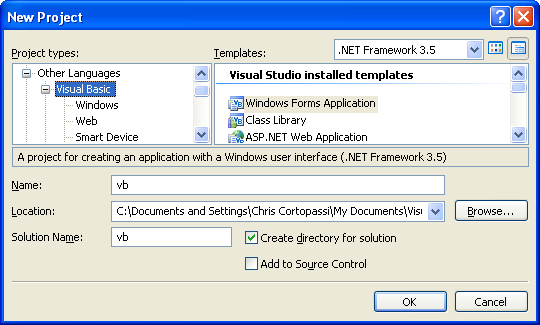
Select Project | Add Reference...
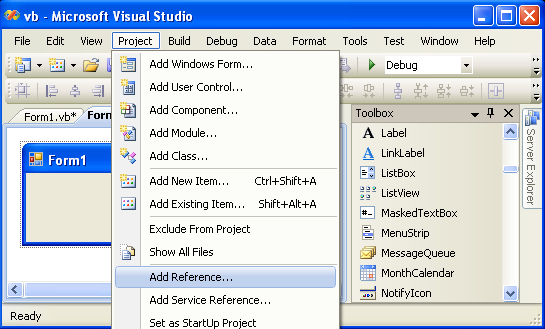
Choose the COM tab, select Galil, and click OK
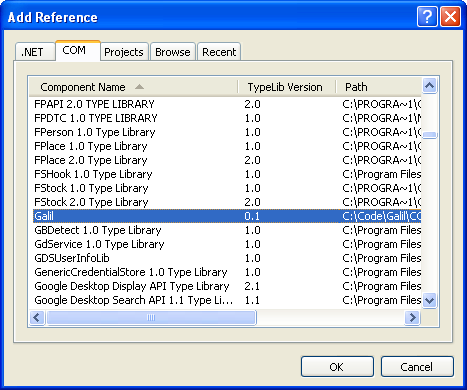
Double click on Form1 and add the code below
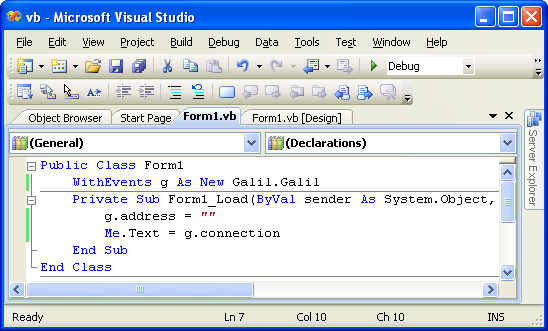
Hit F5 to run the program

C#
Visual Studio or the free-of-charge Express edition may be used (below configures Visual Studio 2008, but versions back to 2002 may be used)
Select Start | All Programs | Microsoft Visual Studio 2008 | Microsoft Visual Studio 2008
Select File | New | Project... | Other Languages | Visual C# | Windows Forms Application and click OK

Select Project | Add Reference...

Choose the COM tab, select Galil, and click OK

Double click on Form1 and add the code below
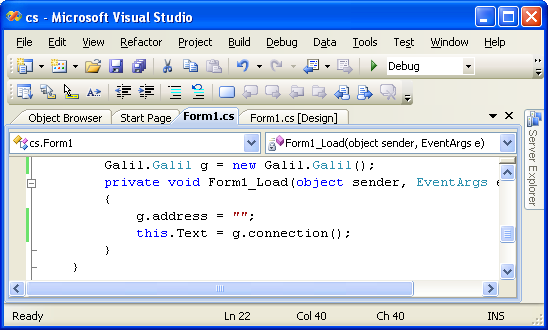
Hit F5 to run the program

C++/CLI
Visual Studio or the free-of-charge Express edition may be used (below configures Visual Studio 2008, but 2005 may also be used). This section covers C++/CLI (Common Language Infrastructure) targeting the CLR (Common Language Runtime). For native (unmanaged) C++, see Visual C++ 2008
Select Start | All Programs | Microsoft Visual Studio 2008 | Microsoft Visual Studio 2008 | File | New | Project... | Visual C++ | CLR | Windows Forms Application and click OK
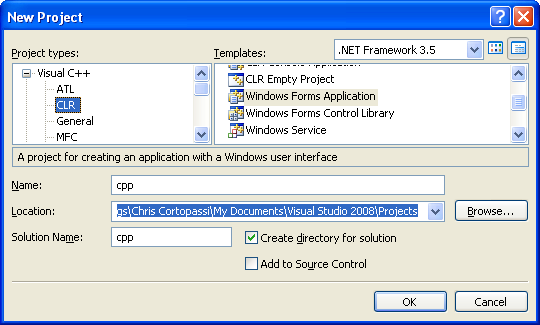
Select Project | Properties... | Add New Reference...
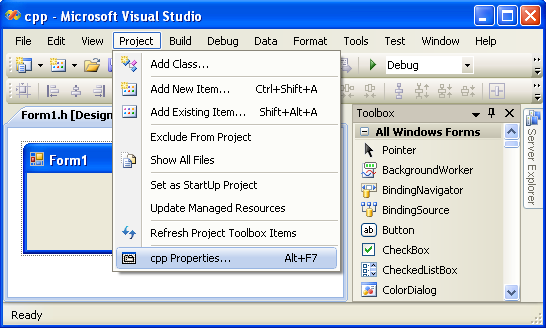
Choose the COM tab, select Galil, and click OK

Double click on Form1 and add the code below
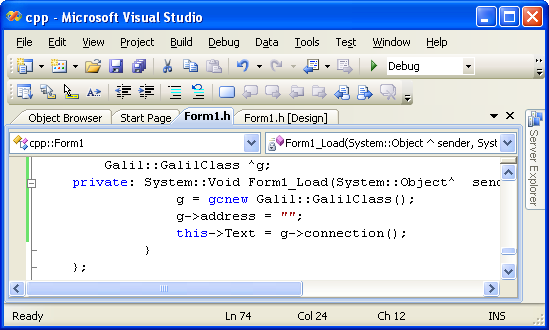
Hit F5 to run the program

Visual C++ 2008
Visual Studio or the free-of-charge Express edition may be used (contact Galil if another C++ compiler is required). This section covers native C++. For managed C++, see C++/CLI
- Open a compiler command prompt
Start | All Programs | Microsoft Visual Studio 2008 | Visual Studio Tools | Visual Studio 2008 Command Prompt
- Change to the directory containing the example C++ program (if you're not an Administrator, you'll need to copy the lib folder to %HOMEPATH% and work there)
C:\Program Files\Microsoft Visual Studio 9.0\VC>cd %ProgramFiles%\Galil\GalilTools\lib
- Compile
C:\Program Files\Galil\GalilTools\lib>cl hello.cpp Galil1.lib /EHsc /MD
Microsoft (R) 32-bit C/C++ Optimizing Compiler Version 15.00.21022.08 for 80x86
Copyright (C) Microsoft Corporation. All rights reserved.
hello.cpp
Microsoft (R) Incremental Linker Version 9.00.21022.08
Copyright (C) Microsoft Corporation. All rights reserved.
/out:hello.exe
hello.obj
Galil1.lib
- Tell Windows where to find Galil1.dll
C:\Program Files\Galil\GalilTools\bin>set path=%path%;%ProgramFiles%\Galil\GalilTools\bin
- Run
C:\Program Files\Galil\GalilTools\lib>hello
1.1.0.4 Aug 29 2008 14:15:14 Galil1.dll
GALILPCI2, DMC1886 Rev 1.0b, 988
...
- If you want to use the GUI debugger (devenv.exe or vcexpress.exe), you'll need to
- add %ProgramFiles%\Galil\GalilTools\bin to your PATH (Start | Control Panel | System | Advanced | Environment Variables)
- File | New | Project... | Visual C++ | General | Empty Project
- In the Solution Explorer, right click Source Files | Add | Existing Item... | C:\Program Files\Galil\GalilTools\lib\hello.cpp
- Set Project | Properties... | Configuration Properties | C/C++ | General | Additional Include Directories to "C:\Program Files\Galil\GalilTools\lib" (QUOTES IMPORTANT!)
- Set Project | Properties... | Configuration Properties | C/C++ | Code Generation | Runtime Library to Multi-threaded DLL (/MD)
- Set Project | Properties... | Configuration Properties | Linker | Input | Additional Dependencies to "C:\Program Files\Galil\GalilTools\lib\Galil1.lib" (QUOTES IMPORTANT!)
Note: GalilTools ships with release libraries (/MD switch above). In order to use debug (/MDd) the user MUST download the debug version of the Galil lib.
Debug libraries and libraries for other versions of Visual Studio are available in the GalilTools archive: http://www.galil.com/support/downloads/software/galiltools/windows/
g++ on Linux
- Change to the lib directory
[dj@localhost Galil]$ cd lib
- Compile
[dj@localhost lib]$ g++ hello.cpp -L. libGalil.so
- Run
[dj@localhost lib]$ ./a.out
1.1.0.4 Aug 29 2008 14:15:14 libGalil.so
/dev/galilpci0, DMC1886 Rev 1.0b, 988
...
LabVIEW
- Open National Instruments LabVIEW and select Blank VI
- On the Front Panel, select View | Controls Palette | Search, type String Indicator, and drop it onto the Front Panel
- Choose Window | Show Block Diagram
- Choose View | Functions Palette | Seach, type Automation Open, and drop it onto the Block Diagram
- Right-click on the Automation Open block and choose Select ActiveX Class | Browse...
- Choose the Galil Version x.x Type Library, click the Galil Object, and click OK
- Right-click on the Automation Open block, choose ActiveX Palette | Property Node, and drop it onto the Block Diagram
- Connect the Automation Refnum terminal of the Automation Open block to the reference terminal on the Property Node
- Left-click on the Property element of the Property Node and choose address
- Choose View | Functions Palette, type String Constant, drop it onto the Block Diagram, and connect it to address
- Right-click on the Automation Open block, choose ActiveX Palette | Invoke Node, and drop it onto the Block Diagram
- Connect the Galil.IGalil (reference output) terminal of the Property Node to the reference terminal on the Invoke Node
- Left-click on the Method element of the Invoke Node and choose connection
- Connect connection to String
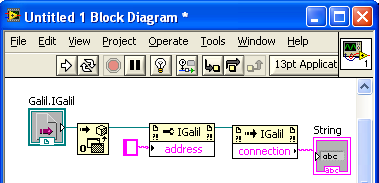
- Hit Ctrl+R to run the VI
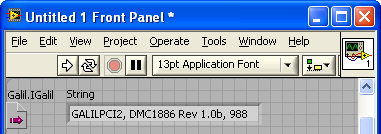
Contents












